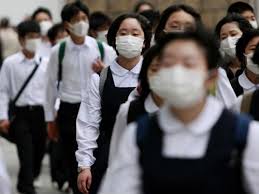Guest
Guest
 |  Subject: U.S evokes emergency act in anticipation of a potential H7N9 pandemic, as flu claims another life in China Subject: U.S evokes emergency act in anticipation of a potential H7N9 pandemic, as flu claims another life in China  Thu May 09, 2013 9:14 am Thu May 09, 2013 9:14 am | |
| U.S evokes emergency act in anticipation of a potential H7N9 pandemic, as flu claims another life in China  Posted on May 9, 2013 by The Extinction Protocol May 9, 2013 – HEALTH – Another patient in China has died from an H7N9 influenza infection, raising the number of fatal illnesses to 32, though no new cases were reported today, holding the overall case total to 131. The World Health Organization (WHO) reported the death today in an update based on information from China’s National Health and Family Planning Commission. The report did not contain any details about the patient who died or his or her location, though the WHO said on its Twitter feed that the death was a retrospective one. The WHO’s update on H7N9 cases today also acknowledged the infection of a 79-year-old woman from Jianxi province, whose case was first announced by Chinese officials yesterday. The WHO said she started having symptoms on May 3. Yesterday Hong Kong’s Centre for Health Protection (CHP) said the woman is in stable condition. In addition, the European Centre for Disease Prevention and Control (ECDC) today published the second update of its rapid risk assessment on H7N9 influenza but said the overall risk to Europe from the disease hasn’t changed. So far nearly all of the cases are sporadic, it said, with no obvious epidemiologic links. “While occasional human-to-human transmission in the clusters cannot be ruled out, there is certainly no confirmation of sustained human-to-human transmission,” the ECDC said. Influenza experts say the slowed pace of new H7N9 cases over the past several days doesn’t suggest that control efforts have removed the threat, and it’s not clear if the virus will fade out or continue to circulate at lower levels during warmer months, a pattern sometimes seen with other flu viruses, The Canadian Press reported today. Michael Osterholm, PhD, MPH, director of the University of Minnesota’s Center for Infectious Disease Research and Policy, publisher of CIDRAP News, said that 2 weeks of activity doesn’t amount to a trend and that it’s impossible to predict if flu activity will wane when the weather warms. He pointed to active transmission of variant H3N2 viruses in connection with US state and country fairs and an August rise in activity during the 2009 H1N1 pandemic. Other flu experts worried that the downturn in cases lead to people lowering their guard about the disease. Keiji Fukuda, MD, the WHO’s assistant director-general for health security and environment, told the Canadian Press that flu fatigue may make it harder to get the prevention message across, but the WHO and its global partners will press ahead with situational awareness activities. In other developments, Medicago, a pharmaceutical company based in Quebec, announced today that it has produced a virus-like-particle (VLP) vaccine candidate against the H7N9 virus, according to a company statement. Medicago obtained the hemagglutinin (HA) sequence for the H7 vaccine from the GISAID database. (Its vaccine does not require the isolate.) It thanked Dr Jun Li and the Hangzhou Center for Disease Control for sharing the sequence of the isolate obtained from a patient in Zhejiang province. The company is purifying the vaccine to prepare for immunogenicity studies in animals, according to the statement. VLP vaccines mimic the structure of a virus but don’t contain any viral DNA or RNA. They can be produced in a variety of platforms; Medicago’s is plant based. Andy Sheldon, Medicago’s president and chief executive officer, said in the statement that the platform is poised to dramatically speed the development of an H7 vaccine, compared with traditional egg-based methods that can take up to 6 months. Vaccine production facilities in Canada and North Carolina position the company as a key player in addressing a potential pandemic, he said. An October report from the CIDRAP Comprehensive Influenza Vaccine Initiative (CCIVI) said VLP vaccines are among the new technologies under development that could make more flu vaccine faster, but it’s not clear yet if the new vaccines would be more effective than currently available ones. –CIDRAP  U.S. evokes emergency act for H7N9: The U.S. government has declared that H7N9 bird flu “poses a significant potential for a public health emergency,” and has given “emergency use authorization” for diagnostic kits for the virus. This mean tests can be used that haven’t gone through the usual lengthy approval process by the US Food and Drug Administration. They are right to be concerned. H7N9 could be a tough adversary: New Scientist has learned that it provokes a weaker immune response than most flu, making vaccines hard to produce. Although H7N9 is not, so far, transmissible between humans, it does cause severe disease in people, is easier to catch than other bird flu strains, and may need only a few mutations to go pandemic. The UK has already given doctors instructions on when to test people for H7N9, and how to manage any with the virus. The US’s emergency authorization will allow the use of a kit that looks for flu genes using a polymerase chain reaction test, which has been made specific for H7N9. The kit has had preliminary tests but would normally need more exhaustive tests to be approved. Innovative new diagnostics should eventually be authorized too, says Charles Chiu of the University of California in San Francisco. This kind of fast, high-throughput screening for pandemic flu, possibly at borders, might allow early cases to be treated with antiviral drugs, potentially slowing the spread of the virus while vaccines are made. The next emergency authorization is likely to be for immune-stimulating chemicals called adjuvants to put in those vaccines. These were used in vaccines in Europe and Canada during the 2009 pandemic, but adjuvants suitable for flu are not currently approved in the US. –New Scientist |
|
Delfi
Elite

Posts : 1827
Reputation : 169
Join date : 2011-08-11
 |  Subject: Re: U.S evokes emergency act in anticipation of a potential H7N9 pandemic, as flu claims another life in China Subject: Re: U.S evokes emergency act in anticipation of a potential H7N9 pandemic, as flu claims another life in China  Thu May 09, 2013 9:30 am Thu May 09, 2013 9:30 am | |
| Thanks for the info ColonelZ, this one sounds dangerous. | |
|
researcher
Admin

Posts : 14660
Reputation : 962
Join date : 2011-08-13
Age : 72
Location : San Diego
 |  Subject: Re: U.S evokes emergency act in anticipation of a potential H7N9 pandemic, as flu claims another life in China Subject: Re: U.S evokes emergency act in anticipation of a potential H7N9 pandemic, as flu claims another life in China  Thu May 09, 2013 12:36 pm Thu May 09, 2013 12:36 pm | |
| - Delfi wrote:
- Thanks for the info ColonelZ, this one sounds dangerous.
Yeah that, but I still won't be taking any so-called "vaccine" for it either. Remember all the hoopla over the swine flu . . . . the big fizzle when millions of people DIDN'T get sick (or dead), and that so-called rush rush to develop vaccine for it that was contaminated with who knows what? The Swine Flew | |
|
Sponsored content
 |  Subject: Re: U.S evokes emergency act in anticipation of a potential H7N9 pandemic, as flu claims another life in China Subject: Re: U.S evokes emergency act in anticipation of a potential H7N9 pandemic, as flu claims another life in China  | |
| |
|





